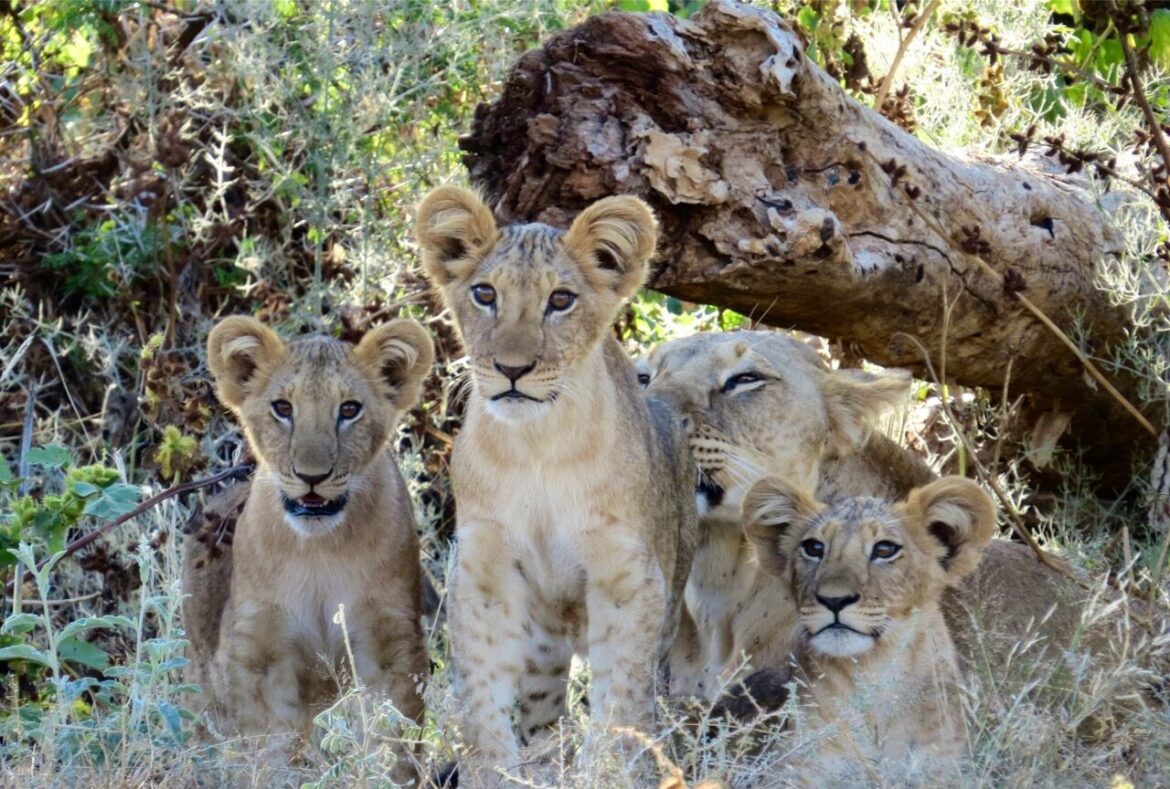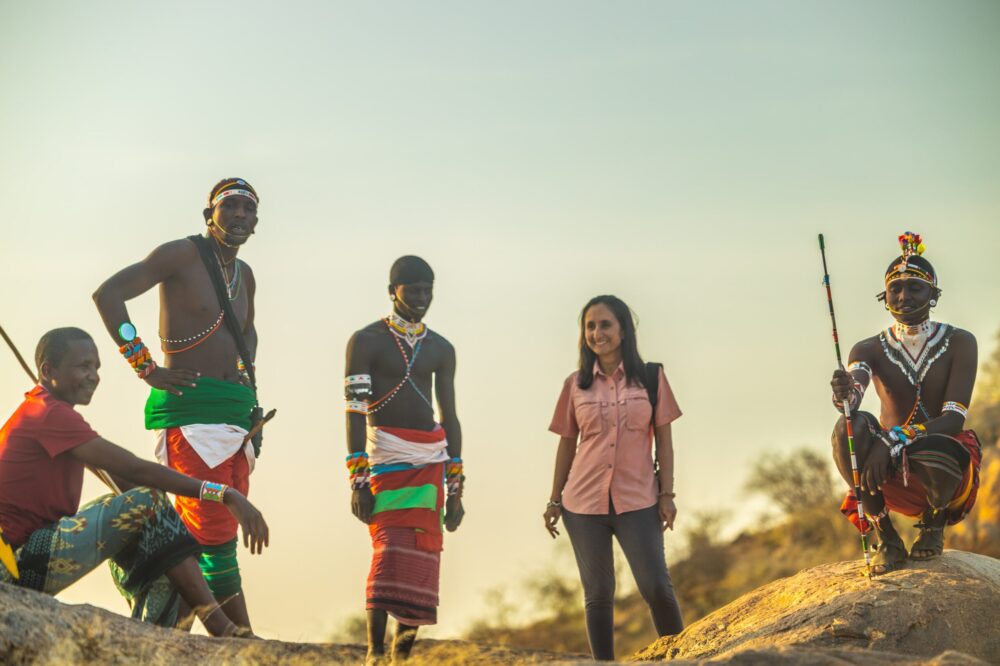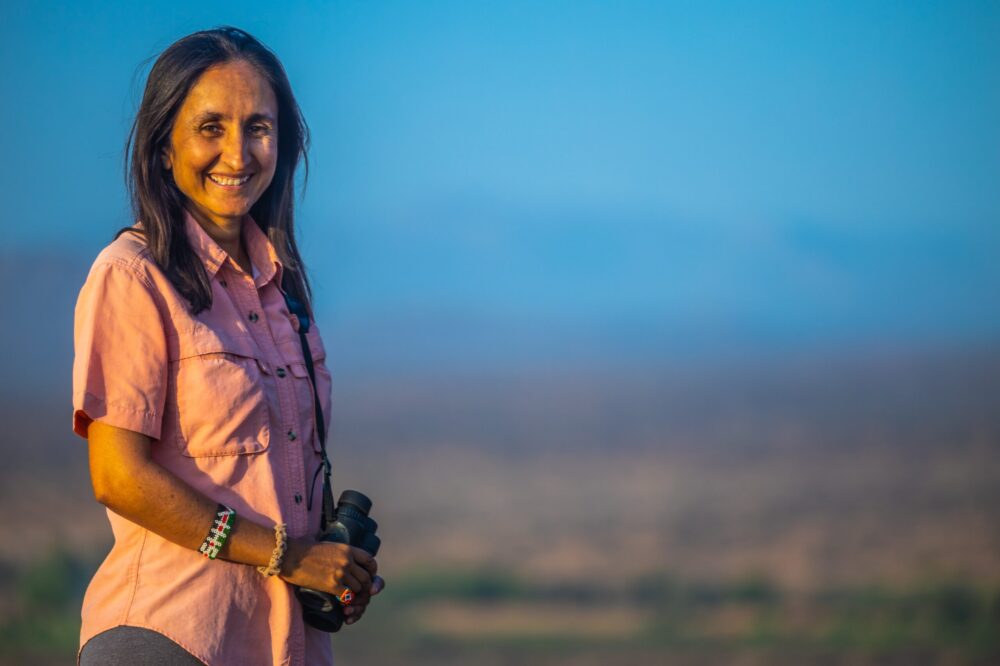Learning to live in harmony with lions
By Nigel Richardson
The lioness was cool, the way she stalked along the sandy track: the gunfighter with the fastest draw. Heedless though she may have been of our vehicle, let alone the outside world, a revolution is taking place around her in northern Kenya that is set to ensure her long-term survival. And tourism is making it possible.
“When you are growing up you think, ‘When I am circumcised I will kill a lion’,” said Jeneria Lekilele, a 25-year-old Samburu warrior who shares this remote part of Kenya with lions. In Jeneria’s childhood, killing a lion proved you were a man, ready to take the step up from boy to warrior. And the lion skin would be used in the circumcision ceremony itself – often a mass affair in which scores of boys were (and still are) bobbed at one go.
These days the Kenyan Wildlife Service provides the lion skins for these coming-of-age ceremonies, and Jeneria Lekilele is bent on protecting the lion, not killing it. He is a field officer with Ewaso Lions, a conservation initiative helping to change hearts and minds in one of Africa’s most conservative cultures.
He is also a powerful role model. “Lions are in my bloodstream,” he told me. “If someone is angry and wants to kill a lion, I get very angry. I feel like I am losing my life. I have changed a lot.”
The plight of the lion is often overlooked when it comes to wildlife conservation in Africa. Rhino and elephant, which are being slaughtered in unprecedented numbers, rightly take the lion’s share of concern; and, indeed, the trade in their horns and tusks will be the dominant theme of the London Conference on the Illegal Wildlife Trade, taking place next Thursday at Lancaster House and attended by the Prime Minister, the Prince of Wales, the Duke of Cambridge (whose conservation concerns have been well documented in these pages) and delegates from 50 countries.
But lions need some loving, too. There may be fewer than 30,000 living wild in Africa, down from hundreds of thousands a century ago, and their existence continues to be threatened by habitat loss and illegal killing. So the story of Jeneria and the lions is a heartening one. But it is just one aspect – albeit a hugely symbolic one – of a more general transformation of this harshly beautiful region of forested mountains and arid lowlands.
The Ewaso Lions project is based in the West Gate Conservancy, 100,000 acres of community-owned land adjacent to Samburu, Buffalo Springs and Shaba National Reserves and less than an hour’s flying time north of Nairobi. West Gate is also home to 3,500 Samburu people, a high-end safari lodge called Sasaab, where I stayed, and game animals (lions in particular) that spill over from the parks. The reason lions cross into community land, explained Shivani Bhalla, the founder of Ewaso Lions, is lack of space.
“Basically the parks are too small for lions – so these areas around the parks are essential for them,” she said. But the spill-over creates a problem – referred to by conservationists as “wildlife-human conflict”.
The Samburu people – like the Maasai, to whom they are related – are nomadic pastoralists, who graze their livestock across vast tracts of bush and desert. Lions kill the livestock, and the Samburu kill the lions in revenge – as well as to prove their manliness. But, thanks partly to Ewaso Lions, attitudes are changing and solutions being found.
“Last week the lions caused a lot of problems,” said Shivani Bhalla, who is studying for a doctorate at Oxford University. “They killed a goat every day.” But there was no reciprocal killing. The Samburu are learning to tolerate a certain amount of predation in return for the greater rewards that the lions bring: tourists.
The tourists arrive by light aircraft – a 50-minute hop from Wilson Airport in Nairobi to a sandy bush strip marked out with white-painted rocks – and stay at Sasaab, a nine-room lodge on a hillside above the Ewaso Nyiro river. Actually “room” should be in inverted commas – each is a secluded tented villa with its own veranda, outdoor plunge pool and river views.
Sasaab was built in 2007 in partnership with the West Gate Community Conservancy. Three-quarters of the 32 staff are local and every guest contributes $50 (£30) a night to community and conservation projects (education bursaries, micro-finance initiatives, wildlife protection, and so on). “We walk a fine line,” said Doug Rundgren, who manages the lodge with his wife, Tanya. “We want to help the community prosper, but we want them to preserve the culture.”
That culture is unadulterated by contact with Westerners. Polygamy and female circumcision are the norm. On my first afternoon Eric Lekolii, a junior elder of the Samburu who works as a guide at Sasaab, took me to a village of brushwood corrals and lozenge-shaped houses made of sticks, plastic and cow dung.
The warriors – young, vain, testosterone-primed men in plumage-like costumes accessorised with bird feathers – were dancing, as they do often (and not for the benefit of tourists). The dances, which involved jumping unfeasibly high, were a celebration of the life they lead, the livestock they own, their virility. These dashing blades may be the future, but they are also potential trouble. “There is conflict between the tribes, especially when there is not enough pasture,” explained Lekolii. “And these are the guys who do those wars.”
The different tribes that eke a living from this inhospitable terrain, where drought and famine are constant threats, have frequently fallen into conflict over livestock and grazing land, and it is the warriors who fight – in the past with spears, more recently with AK47s.
A few years ago this part of Kenya was lawless and dangerous, rife with bandits, cattle rustlers and poachers. But the situation has been turned around thanks to the Northern Rangelands Trust (NRT), an umbrella organisation of community conservancies dedicated to pursuing peace and growth through cooperation and conservation.
One of the NRT’s leading lights, Tom Lalampaa, recently received a prestigious Tusk Award – one of the conservation world’s highest accolades – from Prince William in recognition of the NRT’s achievements.
Tourism, in the form of lodges, campsites, game viewing and adventure activities, represents a peaceable, viable future for the 200,000-plus people living in the conservancies. “Every time they see you around they know you come from afar,” said Lekolii, referring to the warriors I met in West Gate, “and every night you spend here, it benefits them.”
Seeing the warriors dancing was a stirring moment – visually arresting, culturally fascinating, especially with an explanatory commentary from Lekolii. But the cornerstone of the whole Samburu experience is viewing the wildlife, which I did on a morning game drive with Lekolii and his fellow Sasaab guide, Gabriel Salaton. Samburu National Reserve boasts five endangered specialist species, including Grévy’s zebra (exquisitely fine stripes compared to the common-or-garden plains zebra), reticulated giraffe (also finely patterned) and gerenuk, a small antelope that thinks it’s a giraffe (it stands on its hind legs to browse). We saw them all within a half-hour.
One of the gerenuk sightings was a kill. A leopard had dragged the carcass up a tree and was guarding it, draped elegantly in a V of branches, its coat like dappled light. Superb starlings flitted through the branches in iridescent flashes of blue and orange.
There is something about a leopard (its reputation for violent moodiness perhaps) that is both disturbing and compelling. But seeing the lioness set my spirit soaring. As we turned on to that sandy track, she was swaggering – no better word – along just in front of us and barely turned to acknowledge our presence. The lioness’s name was Nashipai, said Salaton. Later, back at Sasaab, I learnt more about Nashipai from another guide, Rosemary Lengunai: “She likes hunting alone and she is a very good hunter. She is aged nine years.” Lengunai is part of Lion Watch, a programme launched this year by Ewaso Lions to encourage interaction between tourists and conservationists.
Thirteen tourist guides who work in Samburu, Buffalo Springs and Shaba National Reserves have been trained in lion identification (there are about 30 lions in the area) and equipped with smartphones with special apps for recording sightings and data. The idea is that they pass on their knowledge and enthusiasm to tourists, who, in turn, are encouraged to become “citizen scientists” by uploading their lion photographs to a new website: lionwatch.org (see also ewasolions.org).
This is a welcome initiative but the focus of the Ewaso Lions project is on building conservation awareness in the local communities. The early part of this year saw a sharp rise in incidents of lions killing livestock. In some cases, with villagers bent on killing the cat responsible, Jeneria Lekilele, the warrior with “lions in his bloodstream”, has risked his own life by standing in the way and refusing to move.
He is, as Shivani Bhalla said, a great example to the other warriors. Through such individuals, the work of the NRT and the role of lodges such as Sasaab, the conservation message is getting through. One of the spectacularly decked-out warriors I met in West Gate was adamant when I asked him if he would hunt a lion that had killed one of his animals: “Why would we kill lion when you come all the way from Europe to see them?”
The original The Telegraph article can be found here: https://www.telegraph.co.uk/travel/destinations/africa/kenya/articles/Kenya-Learning-to-live-in-harmony-with-lions/





